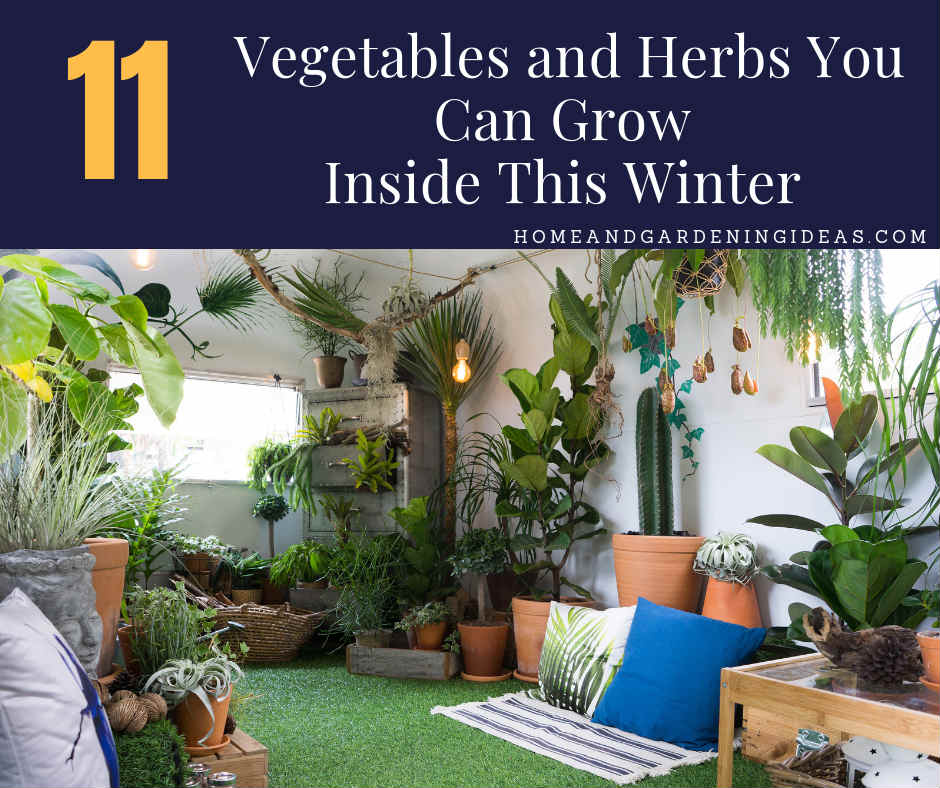11 Vegetables and Herbs You Can Grow Inside This Winter
When you are a gardening lover, the winter times can bring about some serious blues. You have nothing fresh growing, no plants to tend! The garden sits empty, and you stare longingly wishing for spring to arrive.
Did you know those winter garden blues don’t have to happen? Certain vegetables and herbs can grow indoors, so you can have fresh veggies all year long. Not all veggies or herbs fall into this category, so keep reading to discover which ones are perfect for your new indoor garden. Kiss those winter garden blues goodbye.
Carrots
Carrots grow inside of a container easily. The trick is making sure that you select a deep enough container. If the container is too shallow, you will get short carrots. However, you won’t get gigantic carrots from an indoor garden. Short carrot varieties require a pot at least eight inches deep, and longer ones need at least 12 inches.
After you plant the seeds, you need to go back and weed out some of the carrots to make room for growth. Carrots do require artificial lights to grow.
Beets
Beets are full of antioxidants, and who doesn’t love pickled beets? Instead of worrying that you can’t grow enough during the summer months, try growing beets in the winter inside. Just like carrots, you need to make sure you select a deep enough container because beets are a root crop.
Basil
Everyone loves basil, and winter doesn’t mean fresh basil has to leave you. Basil requires a pot that is at least four inches wide with adequate drainage holes. Basil prefers warm temperatures and ample sunlight, which is why its a warm-weather crop. It needs at least six hours of direct sunlight to grow.
You will want to fertilize at least once a month. You will need water probably once a day, or every other day if the temperatures are too hot.
Lettuce
Lettuce is one of the easiest crops to grow, and it doesn’t take up much space. It can grow well on a sunny window. The best picks are leaves that allow you to harvest the leaves, such as cutting leaves or leaf lettuce varieties. A head of lettuce won’t grow so well indoors.
Once you sprinkle in the seeds, cover with only ⅛ inch of soil and mist gently with a spray bottle. Make sure you keep the surface soil damp but not soaked. Lettuce grows well in a sunny window or under a grow light. It’s important to thin the seedlings once they germinate, which encourages the strongest seeds to grow.
Rosemary
The scent of rosemary is intoxicating, and many people believe rosemary helps to improve your memory and improves your cholesterol levels. Rosemary grows well from seeds or by propagating cuttings. You need a deep pot with holes in the bottom for drainage. It prefers an alkaline soil, so try adding one teaspoon of agricultural lime per five-inches of soil. Rosemary grows best in an area that receives six hours of direct sunlight each day!
Arugula
Arugula germinates and grows quickly, making it an excellent choice to grow inside. You will be able to harvest from each plant multiple times if you continue to cut the larger leaves and leaving the smaller ones at the center.
One of the reasons arugula does so well is that it prefers cooler temperatures anyway. If you plant it outside, it is a spring or fall crop in most locations. You can grow arugula right on your windowsill.
Cilantro
Some people dislike the smell and taste of cilantro, but it contains high concentrations of carotenoids, which offers high amounts of vitamin A. You can either purchase coriander seeds (coriander is cilantro in seed form) or use a starter plant. Cilantro grows best in a container that is at least eight inches deep.
Mushrooms
Mushrooms are notoriously tricky to grow, even for experienced gardeners. However, mushrooms are so flavorful, it’s worth the shot to try to grow them indoors. You can purchase a kit to learn how to grow mushrooms. Many people grow mushrooms in laundry baskets in their basements. You don’t even need sunlight! Attics or dark closets are also options for places to grow mushrooms at home.
Scallions
Scallions are a delicious topping for recipes and meals. Many people call scallions green onions. You get that lovely, onion taste without actually growing onions. Scallions can start from seed, or you can pick up some organic scallions at the store. If they still have the roots attached, you can place them in the soil, burying them up to the top of the white bulb. The scallions will grow well and just harvest the tops as you need.
Ginger
Ginger looks like bamboo, making it an attractive plant. You can pick up ginger at a local natural food store; most use little to no chemicals. You can soak the ginger in water for a few hours first to remove growth chemicals.
To grow ginger inside, you need to place the root into a wide, shallow container and barely cover it with soil. Keep the soil moist, but not saturated, and it will grow!
Microgreens
Microgreens provide you with a source of vitamin A, C, K, and folate. They aren’t a special variety of greens, but rather microgreens are seedlings of herbs and vegetables. You start by selecting a variety of seeds to grow, like radishes, kale, beets, basil, and dill. Use a seedling tray, which is a shallow tray about two inches deep, and fill with soil. Spread the seeds evenly and sift a thin layer of soil over top.
You can grow microgreens right on a sunny windowsill in your house that is between 60 and 70 degrees F. Make sure you mist with water daily.
This list is far from exhaustive. There are so many veggies and herbs that you can grow indoors! It’s a great way to beat back those winter gardening blues. Plus, growing these plants inside provides your family with fresh produce throughout the entire year.
 Home and Gardening Ideas At home and Gardening ideas we believe inspiring readers about homesteading, self sufficiency
Home and Gardening Ideas At home and Gardening ideas we believe inspiring readers about homesteading, self sufficiency











